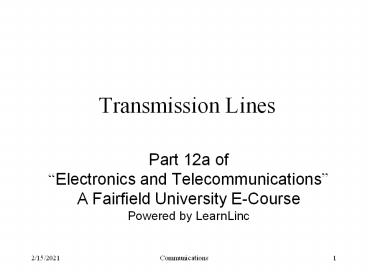Transmission Lines - PowerPoint PPT Presentation
Title:
Transmission Lines
Description:
Transmission Lines Part 12a of Electronics and Telecommunications A Fairfield University E-Course Powered by LearnLinc – PowerPoint PPT presentation
Number of Views:193
Avg rating:3.0/5.0
Title: Transmission Lines
1
Transmission Lines
- Part 12a ofElectronics and TelecommunicationsA
Fairfield University E-CoursePowered by
LearnLinc
2
Module Digital Systems (in two parts)
- Texts
- Computers, Capron, Benjamin Cummings, 1996,
ISBN 0-10053-0662-5 - Telecommunications, Blyth, McGraw-Hill, 1990,
ISBN 0-02-61001041-2 - Understanding Telephone Electronics, Bigelow,
Newnes, 1997, ISBN 0-7506-9944 - References
- Electronics Tutorial (Thanks to Alex Pounds)
- Electronics Tutorial (Thanks to Mark Sokos)
- Part 9 Computers
- 5 on-line sessions plus one lab
- Part 10 Digital Communications
- 5 on-line sessions plus one lab
- Mastery Test part 5 follows this Module
3
Section 11 Broadcast Systems
- Frequency Division Multiplexing
- AM
- Modulation
- Demodulation (The Envelope Detector)
- FM
- Modulation
- Demodulation (The Phase-Locked-Loop)
- Super Heterodyne Receivers
- Television
- Sampling
4
Section 12 Transmission and Networks
- Transmission Lines
- Twisted pair
- Coaxial Cable
- Optical Fiber
- Microwave Systems
- Satellite Links
- Telephone Systems
- Local Area Networks
- Cellular Phone Systems
5
Section 12 Schedule
Session 12a 09/24 Transmission Lines, Radio, Microwave Satellites Bigelow 36-42 WWW, notes
Session 12b 09/29 POTS Bigelow 1-36, 47-78, WWW, notes
Session 12c(No Class 10/06) 10/01 Telephone Systems the CO Bigelow 79-106, 211-251
Session 12d(No class 10/13) 10/08 LANs WWW, notes
Session 12e 10/15 Cell Phone Systems Bigelow 332-341 WWW, notes
Session 12f (Lab - 10/25, Sat.)(Quiz 12 due 10/26) 10/20 Review for Quiz 12
Session 12g 10/27 Quiz 12 Results
Session 12h 10/29 MT 6 QA
MT6 (Sat, Cheshire) 11/01 MT 6
MT6 Results 11/03 MT 6 Results
6
Transmission Media Get signals from here to there
- Copper
- Unbalanced, open wire line
- Pair
- Untwisted or Twisted
- Unbalanced or Balanced
- Coaxial cable
- Radio
- Free Space Antennas
- Microwave
- Free Space
- Wave Guides
- Satellite
- Optical
- Free Space
- Fiber
7
A Transmission Line
- Signal goes in voltage, current, characteristic
impedance (Z0) - Signal propagates as an electromagnetic wave
(speed of light) - Signal comes out and is absorbed in the
termination impedance - Attenuation (loss)
- Reflection (impedance mismatch)
8
Open Wire Line
- Signal travels on a copper wire Use Ground as
a return - Good
- Low cost
- Bad
- Susceptible to interference and crosstalk
- Induced signals due to open loop structure
- Common impedance in ground path
- High loss in the ground return
9
Unbalanced Pair
- Add a copper return (neutral) wire
- Good
- Lower loss in the return path for the current
- Independent return path
- no common coupling impedance
- Bad
- Open structure still allows induced signals
- Reduced by keeping signal and return lines close
- Further reduced by twisting
- Adds cost
10
Balanced Pair
- Put signal on one line and minus the signal on
the other line - Good
- Coupled signals tend to cancel each other out
- Common mode rejection
- Twisting very effective (Method used today)
- Bad
- Adds cost
- Balance maintenance requires care
- Audio transformers, center tapped
- Differential operational amplifiers
11
Coaxial Cable
- Signal travels down the inner conductor and
returns via the shield (outer conductor) - Good
- Isolated from the rest of the world by the shield
- Consistent impedance, large bandwidth (1 GHz)
- Bad
- Cost and connectors
12
Line of Sight Radio
- Radio waves tend to go in a straight line
(especially at high frequencies) - The earth (and other obstacles) can get in the
way - Signals can bounce off surfaces
13
Satellite
- Uplink
- Earth station
- Downlink
- Satellite transmits a footprint
- Received by microwave dish
- Geo-stationary
- 22,000 miles high
- Remains fixed over a spot on the equator.
- Allows a fixed receiving antenna
14
Satellite Systems
- Higher frequency shorter wavelength smaller
dish - Satellite TV uses high frequencies and a high
power satellite transmitter to allow 18
receiving dish.
15
Free Space Optical
- Use lasers and photo-detectors
- Fog, rain, snow, and leaves can cause problems
16
Optical Fiber
- Light travel down a thin Glass Fiber
- What keeps it in? hint the speed of light is
slower in high index glass
17
Section 12 Schedule
Session 12a 09/24 Transmission Lines, Radio, Microwave Satellites Bigelow 36-42 WWW, notes
Session 12b 09/29 POTS Bigelow 1-36, 47-78, WWW, notes
Session 12c(No Class 10/06) 10/01 Telephone Systems the CO Bigelow 79-106, 211-251
Session 12d(No class 10/13) 10/08 LANs WWW, notes
Session 12e 10/15 Cell Phone Systems Bigelow 332-341 WWW, notes
Session 12f (Lab - 10/25, Sat.)(Quiz 12 due 10/26) 10/20 Review for Quiz 12
Session 12g 10/27 Quiz 12 Results
Session 12h 10/29 MT 6 QA
MT6 (Sat, Cheshire) 11/01 MT 6
MT6 Results 11/03 MT 6 Results































